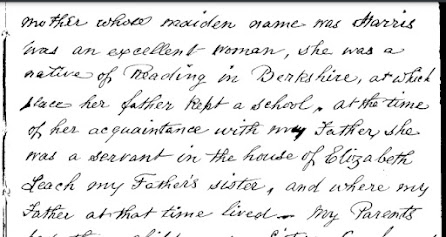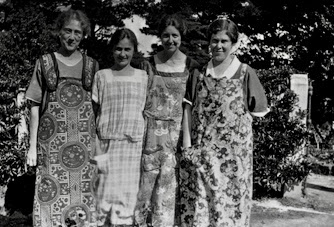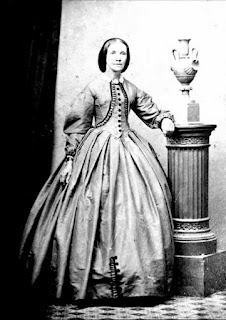17/52 Document; Ann Harris, - 1791
17/52 Document. Ann Harris.
The main document I rely on to write her story is the memories of their son, dictated to his daughter, Sarah, their grand daughter. The copy I had was not the one Sarah wrote down. That one was copied out again by one of her sisters and sent to a brother in Australia, where it was copied again, and given to his daughter, my great aunts’ aunt. Eventually it came to my mother and then to me. This is my most precious family history document. It weighed heavily on me. What if the house burned down and I lost it? I transcribed it and donated it to a library so now it is safe and available on line.
Since Ancestry I have been able to access other documents to confirm these stories but the first source is the Recollections of Early Life of John Godlee.
When Thomas Godlee, John Godlee’s father, was ten years old both his parents died. His father died in the captivity of Spaniards, his mother, Margaret née Watts, the same year. How long was he in captivity before he died? Where was he captured and in what circumstances? Was she with him? Did she die of grief? Suicide? These are the unanswered questions about the Quaker parents of Thomas. Thomas had two older sisters, Elizabeth, who was 17 when her parents died and Margaret was twelve. All these children had been registered in Quaker Birth records at the Monthly Meeting of Ratcliff and Barking. Luckily they also had two rich uncles: John and Burwood who were in the Shipping trade in the Mediterranean. They supported their brother’s orphaned children.
All this family lived around Limehouse, an area associated with seafaring, supplying ships with ropes and other necessities. It was a bustling multi-cultural location with London’s first China Town. Thomas, Elizabeth and Margaret had been born in Narrow Street, and other streets mentioned in John’s recollections of his father’s youth are Burr Street,(‘paved with flat stones, long before such pavement was general throughout London’) Swithers Lane, Tower Street.
In the Recollections John recounts his father’s youth:
He was sent to Sea when very young and at 18 years of age was actually entrusted with the command of a ship by his uncle John. I have often heard him speak of this circumstance as far from beneficial to the formation of his character. This, his first ship, was named the Brittania. He made several voyages up the Mediterranian in her, but after marrying in a manner that his uncle did not approve, the ship was taken from him.
So Thomas first commanded the ship in 1743. When he was in London he lived with his sister, Elizabeth who, in 1746, married a tallow chandler, John Leach. Ann Harris was a servant at their house. According to his son’s recollections, Thomas was later critical of his own ‘character’ at this time and I wonder what went on. Did Thomas get Ann up the duff? If he did, she lost the baby. They married on January, 6th 1750. It is registered in the Clandestine Marriage Register. Ancestry notes about the document.
If you think Vegas is tacky, consider this: prisons like the Fleet and the King’s Bench were once popular destinations for folks interested in quick, no-questions-asked nuptials—like the couples in these records.
‘Clandestine marriages’ were also conducted at Mayfair Chapel and indeed, Thomas and Ann’s marriage is registered with St George’s Chapel, Mayfair, a private chapel which performed marriages without banns or license. This continued until 1754 when the Marriage Act made these marriages illegal. Prior to that some six thousand marriages a year were taking place in the chapel, some of them of Dukes and Lords. In 1750 Thomas and Ann married outside the Society of Friends, without the permission of the Meeting and the approval of the Uncles.
John Godlee continues the story:
Their first child Joseph was born in 1758 in Limehouse. They had been married for eight years. It seems a long time to be married without any pregnancies. Soon after Joseph, a sister Mary was born in Leghorn the following year in 1759.He, however, continued to follow a sea-faring life, being variously employed and was at last in the Navy. He frequently took his wife to sea with him, and one of their children was born at Leghorn.
Googling ‘women at Sea in the Eighteenth Century’ reveals that in the British Navy it was not uncommon for wives of petty officers to travel with their husbands. It wasn’t exactly approved of or officially recognised but women who stayed at home may not have any income and the ship provided them with a home. They may have worked on the ship, doing mending or laundry, serving as maids to the captain. As they were not officially there they did not enter into the muster books and were not paid or fed by the Navy. We know they were there because of references in memoirs like John Godlee’s Recollectios.
Perhaps Thomas and Ann didn’t have any children in eight years of marriage because they never spent much time together. Thomas was at sea and Ann had to keep working to support herself as a servant to Thomas’s sister Elizabeth. Then he reached a certain rank or started working for the Navy, enabling her to travel with him. The birth of two children in 1758 and 1759 suggests they were finally able to cohabit. Presumably little Jo was aboard ship with his parents in Leghorn.
Leghorn is what the English call Livorno, a port city on the Western coast of Tuscany. It had been an important free port
‘giving rise to intense commercial activity, in the hands, for the most part, of foreign traders, and seat of consulates and shipping companies, becoming the main port-city of [Tuscany.] The status of a multiethnic and multicultural Livorno lasted until the second half of the nineteenth century;
John Godlee gives a fascinating little detail about life in Leghorn:
I remember hearing my mother say that this infant, being carried out in the street there, excited great attention and the pins in its dress were regarded as remarkable curiosities.
The wonders of early Industrial England on show to the Italians in the form of a nappy pin!
Sadly that infant, Mary, did not survive. Joseph too died before his fifth birthday.
When their third child, John, was born in 1762 Ann was living on the Ratcliffe Highway which ran north of the Thames, just up from the docks in Wapping. The church, St George in the East, (not to be confused with St Georges Chapel, Mayfair,) where all their children were baptised, is on the Ratcliffe Highway. It was a busy sea fearing area, frequented by Captain James Cook when he was home from his Pacific explorations. I like to imagine Thomas and Ann passing him in the bustling streets.
Three more children followed: Margaret, (1765), Sarah, (1766) and Elizabeth (1770). They were all born on Ratcliff Highway, Limehouse.
The Recollections continue :
My father was wounded in an engagement under Admiral Hawke and was disabled.
Admiral Hawke was a Royal Navy Officer who was involved in many successful battles against the French during the Austrian War of Succession and the Seven Years War. In 1761 he retired from active service and became a rear Admiral and eventually Admiral of the Fleet. The engagement when Thomas was injured must have been between 1768 and 1771. Hawke was influential in the appointment of James Cook to the Pacific expedition.
John says that after his father was disabled and had to retire from active service at sea,
He was made secretary of the Trustees of Ramsgate Harbour and retained this place until his death.
I assumed that when Thomas got work as the secretary for the Trustees of Ramsgate Harbour, the family would have moved to live in Ramsgate, enjoying the bracing sea breeze instead of the stinking inner-city Thames. I imagined that John, sent to Greenwich to school from when he was seven, a special navigation school for Navy sons, would have come to Ramsgate in the holidays. But closer reading of the Recollections suggests they lived in London. The Trustees of Ramsgate Harbour apparently had offices in town.
John was sent to sea as a cabin boy and was away for three years until 1779 when, following the occupation of Philadelphia, he says :
Thus I had been out three years, during the first two of which, I had no communication with my family. Some person to whom they wrote found me out at Philadelphia and gave me news of them. I afterwards wrote regularly. I was received at home with great joy and staid amongst them some months.
He returned for a short visit in ’81 but in ’82, he says:
I found on my return to my relations, that my father had died during my absence. My mother was residing in the same house in which they had lived together, no 4 Adam’s Court, Old Broad Street. She had a small annuity from the Trustees of Ramsgate Harbour, upon which she lived.
Ann spent the ten years of her widowhood at Adam’s Court, living with her unmarried daughters, Sarah and Elizabeth. I picture them in the front room, working on their needlework and watching the passersby in the street, a bit like middle class characters in a Jane Austen novel, say Mansfield Park. I don’t know how old Ann was when she died but Thomas had been 56, so she was probably in her 60s. She died at the end of winter in 1791 and was buried in Islington.
references
bbc.co.uk/history/british/empire_seapower/women_nelson_navy_01.shtml
England, Church of England Baptisms, Marriages and Burials, 1538-1812
https://eprints.utas.edu.au/23465/
marinersmuseum.org/sites/micro/women/goingtosea/navy.htm
Registers of Clandestine Marriages and of Baptisms in the Fleet Prison, King's Bench Prison, the Mint and the May Fair Chapel.
UK, Burial and Cremation Index, 1576-2014
Westminster, London, England, Church of England Baptisms, Marriages and Burials, 1558-1812
wikipedia.org/wiki/Edward_Hawke,_1st_Baron_Hawke
wikipedia.org/wiki/Keith%27s_Chapel
wikipedia.org/wiki/Narrow_Street




Comments
Post a Comment